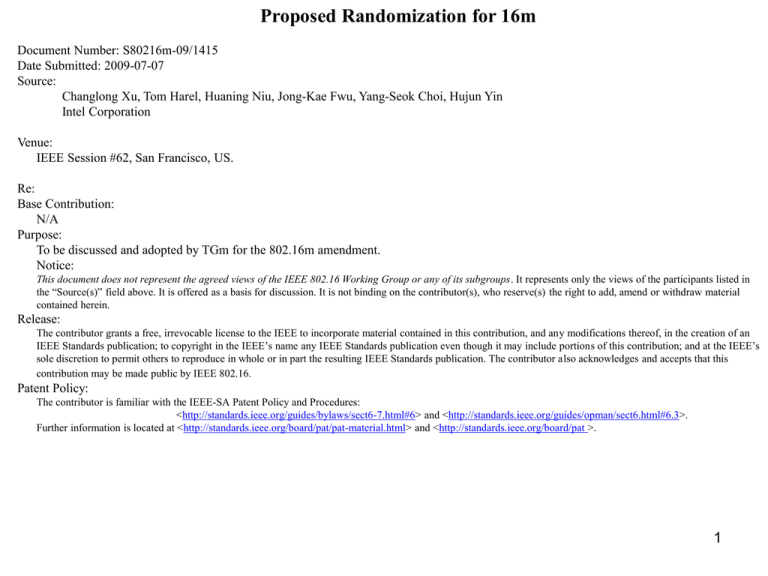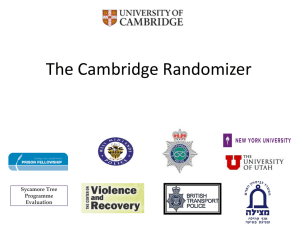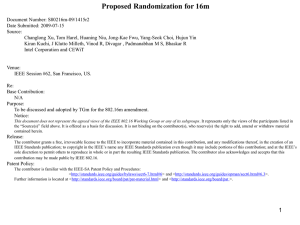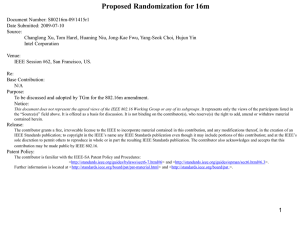Proposed Randomization for 16m
advertisement

Proposed Randomization for 16m Document Number: S80216m-09/1415 Date Submitted: 2009-07-07 Source: Changlong Xu, Tom Harel, Huaning Niu, Jong-Kae Fwu, Yang-Seok Choi, Hujun Yin Intel Corporation Venue: IEEE Session #62, San Francisco, US. Re: Base Contribution: N/A Purpose: To be discussed and adopted by TGm for the 802.16m amendment. Notice: This document does not represent the agreed views of the IEEE 802.16 Working Group or any of its subgroups. It represents only the views of the participants listed in the “Source(s)” field above. It is offered as a basis for discussion. It is not binding on the contributor(s), who reserve(s) the right to add, amend or withdraw material contained herein. Release: The contributor grants a free, irrevocable license to the IEEE to incorporate material contained in this contribution, and any modifications thereof, in the creation of an IEEE Standards publication; to copyright in the IEEE’s name any IEEE Standards publication even though it may include portions of this contribution; and at the IEEE’s sole discretion to permit others to reproduce in whole or in part the resulting IEEE Standards publication. The contributor also acknowledges and accepts that this contribution may be made public by IEEE 802.16. Patent Policy: The contributor is familiar with the IEEE-SA Patent Policy and Procedures: <http://standards.ieee.org/guides/bylaws/sect6-7.html#6> and <http://standards.ieee.org/guides/opman/sect6.html#6.3>. Further information is located at <http://standards.ieee.org/board/pat/pat-material.html> and <http://standards.ieee.org/board/pat >. 1 Outline • Data randomization and subcarrier randomization in 16e • Data randomization in current AWD text • Proposed randomization • Summary 2 1. Data randomizer and subcarrier randomizer in 16e Subcarrier randomizer Data to transmit in PHY burst Randomizer (8.4.9.1) FEC (8.4.9.2) Bit-interleaver (8.4.9.3) Repetition (8.4.9.5) Modulation (8.4.9.4) Mapping to OFDMA subchannels Figure 1 Channel coding process for regular and repetition coding transmission 3 1.1 Data randomizer LSB MSB 1 2 3 4 5 6 7 8 9 10 11 12 13 14 15 data out data in • Generator polynomial 1 + x14+x15 • Initial Vector [LSB] 0 1 1 0 1 1 1 0 0 0 1 0 1 0 1 [MSB] –Each FEC block • Function Avoiding long runs of bit that are bad for modulator Example, long runs of 1’s, coming from the data source or padding, generate the peak amplitude of 64 QAM modulator consumes 3.7dB higher power than the average. 4 1.2 Subcarrier Randomizer LSB 1 MSB 2 3 4 5 6 7 8 9 10 11 wk • • Generator polynomial 1 + x14+ x15 Initial Vector - Each sub-frame – b0 .. b4 5 LSB of IDcell – b5,b6 the segment number + 1 – b7..b10 0b1111 for downlink; four least significant bits of the Frame number in the uplink. • Function – Randomize the interference between different cells – Avoid exact repetition of QAM symbol. Repetition within an OFDM symbol causes high PAPR and repetitive interference. 5 2. Data randomization in current AWD text Subcarrier randomizer Necessary Burst CRC encoder Data Randomizer Burst partition FEC block CRC encoder FEC encoder Bit selection & Repetition Collection Modulation Figure 2 Channel coding procedure in current AWD text Problem: Data Randomize is same as that in 16e. Thus, subcarrier randomizer is necessary. Solution: 1. Adding subcarrier randomizer 2. Proposed algorithm 6 3. Proposed randomization Move randomizer to the position before the modulation Burst CRC encoder Data Randomizer Burst partition FEC block CRC encoder FEC encoder Bit selection & Repetition Collection Modulation 7 Parameters for proposed randomization LSB 1 MSB 2 3 4 Data in 5 6 . . . 18 19 20 21 22 23 Data out • Generator polynomial 1 + x18+x23 • Initial Vector b13 … b22 IDcell b12 1 b0 … b11 STID Reset the seed for each burst 8 Summary • Proposed a new randomizer instead of the original one in current AWD • Merit of the proposed randomizer – Low complexity (one randomizer instead of the two randomizer in 16e) – Good performance • Randomize the interference between adjacent cell • Avoid exact repetition of QAM symbol • Avoiding long runs of bit 9 10


